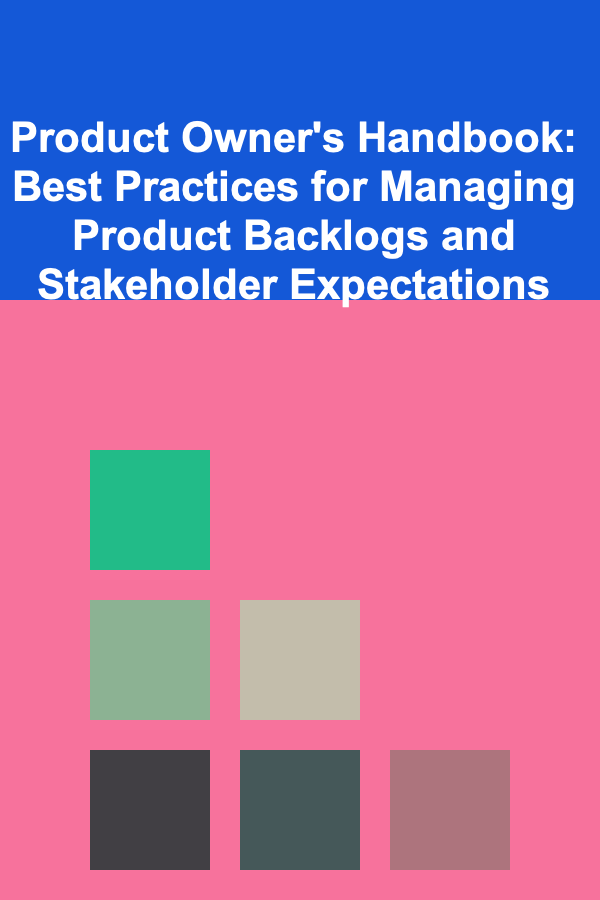
Product Owner's Handbook: Best Practices for Managing Product Backlogs and Stakeholder Expectations
ebook include PDF & Audio bundle (Micro Guide)
$12.99$9.99
Limited Time Offer! Order within the next:

The role of a Product Owner (PO) is one of the most pivotal in agile product development. As the individual responsible for maximizing the value of the product, the Product Owner plays a key role in managing the product backlog and aligning stakeholder expectations with the development team's capabilities. This handbook will provide an actionable guide to the best practices for managing product backlogs and stakeholder expectations, helping you navigate the complexities of this critical role with confidence.
The Foundation of Effective Product Ownership
Before diving into best practices for managing the product backlog and stakeholder expectations, it's essential to understand the core responsibilities of the Product Owner:
- Vision and Strategy: The PO is the bridge between business goals and the technical team. A clear product vision, aligned with the company's strategic objectives, is critical to ensuring everyone is pulling in the same direction.
- Value Maximization: The PO's primary role is to maximize the value delivered by the product. This involves prioritizing work based on business value and ensuring the team focuses on the most important features first.
- Stakeholder Communication: The PO must maintain a delicate balance between listening to stakeholders, understanding their needs, and ensuring that those needs align with the strategic direction of the product.
- Backlog Management: The PO is responsible for maintaining and refining the product backlog. This is a living document that needs constant attention and adjustment based on changing priorities and insights.
With this foundation in mind, let's delve into actionable best practices for managing the product backlog and setting clear stakeholder expectations.
Mastering Product Backlog Management
The product backlog is the heart of the product development process. It's a dynamic list of features, enhancements, bug fixes, and technical tasks that need to be completed. Proper management of this backlog ensures that development efforts are aligned with business priorities and can adapt to new information.
2.1 Create a Clear, Structured Backlog
A well-organized product backlog allows the team to understand exactly what needs to be done and why. Here's how to structure it:
- Use Clear, Actionable User Stories : Each backlog item should be a well-written user story that clearly defines what value it brings and who it's for. Following the format of "As a [user], I want to [do something] so that [I can achieve a benefit]" helps maintain focus on user value.
- Prioritize by Value, Not Effort : It's easy to prioritize tasks based on how much effort they will take, but this doesn't always align with business value. Always prioritize work based on the value it will deliver to the customer or business, not just the effort required. Techniques like MoSCoW (Must have, Should have, Could have, Won't have) or Kano Model can be used to help rank backlog items by value.
- Break Down Large Epics: Large features or epics should be broken down into smaller, more manageable user stories. This will help in continuous delivery and ensure that smaller increments of value are released more frequently.
- Include Technical Debt: Don't forget to include tasks related to refactoring, addressing technical debt, and improving infrastructure. While these may not deliver immediate business value, they are essential for the long-term health of the product.
2.2 Refine the Backlog Regularly
The backlog is a living document, and it should evolve based on new insights, customer feedback, and changing business priorities. Regular backlog refinement (or grooming) sessions are essential for keeping it up to date.
- Set Regular Refinement Sessions: Conduct regular backlog grooming sessions with your development team. These sessions should focus on ensuring backlog items are well-defined, prioritized, and sized appropriately. A good rule of thumb is to refine the backlog at least once per sprint.
- Involve the Right Stakeholders: Backlog refinement should not only include the product development team but also relevant stakeholders such as business analysts, architects, and UX/UI designers. Their insights can help refine user stories and ensure that the team has all the information needed to move forward.
- Keep the Backlog Lean: While it's tempting to add every idea that comes up, your backlog should only contain items that are important for the product's success. Regularly remove outdated or irrelevant items to keep the backlog lean and focused on high-value features.
2.3 Ensure Visibility and Transparency
The backlog is not just for the development team---it should be visible to all stakeholders. Transparency is critical for ensuring everyone is aligned and working toward the same goals.
- Use a Tool for Backlog Visibility : There are many tools available for managing product backlogs, such as Jira , Trello , or Asana. Use a tool that allows both your development team and stakeholders to view and understand the backlog's status, priorities, and changes in real-time.
- Communicate Priorities: Make sure that stakeholders understand why certain items are prioritized over others. You can use regular updates, such as sprint reviews or status meetings, to explain the rationale behind backlog prioritization and ensure that everyone is on the same page.
Setting and Managing Stakeholder Expectations
One of the most challenging aspects of being a Product Owner is managing stakeholder expectations. Stakeholders will often have competing interests and a range of demands that can be difficult to balance. Setting clear expectations and keeping stakeholders informed is key to maintaining trust and alignment throughout the development process.
3.1 Understand Stakeholder Needs and Priorities
Before you can manage expectations, you must first understand what stakeholders value most. This involves:
- Building Relationships with Stakeholders: Take the time to understand the motivations, goals, and pain points of your stakeholders. Regular communication and engagement will help you align your backlog to what is most important to them.
- Clarify Expectations from the Start: At the outset of the project, set clear expectations regarding timelines, feature sets, and resource constraints. Understand that scope changes will occur, but it's important to be transparent about what is feasible and what is not.
- Use Roadmaps to Set Long-Term Expectations: A product roadmap provides a high-level view of the product's direction over time. Share this roadmap with stakeholders so they can see the big picture and understand where their requested features or improvements might fall in the timeline.
3.2 Communicate Regularly and Effectively
Stakeholders must be kept informed about the product's progress, and they need to know when to expect certain features or fixes. Effective communication can prevent misunderstandings and frustration.
- Hold Regular Stakeholder Meetings: Set up recurring meetings with key stakeholders to discuss progress, upcoming releases, and any changes in the product direction. These meetings can be in the form of sprint reviews, demos, or even dedicated stakeholder update sessions.
- Be Honest About Constraints: If timelines or feature sets need to be adjusted, be open and honest about it. Managing expectations is about balancing ambition with reality, and stakeholders appreciate transparency when there are challenges.
- Provide Clear Updates: Share clear, concise updates on progress, including what has been completed, what's in progress, and what might be delayed. Utilize visual aids such as burn-down charts, release notes, or product demos to communicate progress.
3.3 Prioritize Stakeholder Requests
Stakeholders will inevitably have many requests, and not all of them can be prioritized. As the Product Owner, it's your responsibility to balance these requests with the product's overall vision and strategy.
- Involve Stakeholders in Prioritization : While you are the decision-maker, involving stakeholders in the prioritization process can help them understand why some features are more important than others. This can be done through prioritization frameworks, like the MoSCoW method or the Weighted Shortest Job First (WSJF).
- Negotiate Trade-offs: Some stakeholder requests may be in direct conflict with others. In these situations, use data and business logic to negotiate trade-offs. If necessary, offer alternative solutions that may achieve similar outcomes without compromising the product's direction.
- Manage Scope Creep: It's important to guard against scope creep by keeping the focus on the product's vision and the defined roadmap. If new requests or changes arise, evaluate them against the existing priorities and make sure they truly add value before committing to them.
Continuous Improvement
Managing a product backlog and stakeholder expectations is an ongoing process. Constantly evaluate how you're handling these responsibilities and seek ways to improve.
- Solicit Feedback: Regularly ask for feedback from your development team and stakeholders on how the backlog is being managed and whether expectations are being met. This can help you identify areas for improvement.
- Learn from Experience: Product ownership is an iterative process. Learn from past experiences, whether successes or failures, and apply those lessons to future backlog management and stakeholder communications.
Conclusion
The role of the Product Owner is both challenging and rewarding. By mastering the art of backlog management and stakeholder communication, you can ensure that your product development efforts are aligned with business goals and customer needs. Prioritize the highest-value items, keep stakeholders informed, and continuously improve your processes. By doing so, you'll not only drive the success of your product but also build strong, trusting relationships with both your development team and stakeholders.
Reading More From Our Other Websites
- [Metal Stamping Tip 101] Speed, Precision, and Cost-Efficiency: The Key Advantages of Metal Stamping for Mass Manufacturing
- [Home Pet Care 101] How to Teach Your Pet Basic Commands for Better Behavior
- [Home Security 101] How to Maximize the Effectiveness of Your Home Security Camera Field of View
- [Home Lighting 101] How to Brighten Dark Rooms with Creative Lighting Solutions
- [Organization Tip 101] What Steps Can You Take to Organize Your Dining Area?
- [Toy Making Tip 101] DIY Playtime: Crafting Perfect Toys Together with Your Best Friend
- [Home Budget 101] How to Create a Home Budget That Works: Tailoring Your Plan
- [Trail Running Tip 101] Hydration & Nutrition Hacks for Human‑Dog Trail Running Duos
- [Personal Care Tips 101] How to Apply Shaving Cream for a Comfortable Shave
- [Skydiving Tip 101] Choosing the Perfect Skydiving Jumpsuit: Materials, Fit, and Safety Features

How to Deep Clean Your Kitchen in 30 Minutes
Read More
How to Maintain Hardwood Floors to Keep Them Looking New
Read More
How to Organize Your Bathroom Products for Easy Use
Read More
How to Profit from Deep Learning Models in the E-commerce Industry
Read More
How to Sell Virtual Fitness Training Services on Social Media
Read More
How to Organize Your Literary Agent Research with a Planner
Read MoreOther Products

How to Deep Clean Your Kitchen in 30 Minutes
Read More
How to Maintain Hardwood Floors to Keep Them Looking New
Read More
How to Organize Your Bathroom Products for Easy Use
Read More
How to Profit from Deep Learning Models in the E-commerce Industry
Read More
How to Sell Virtual Fitness Training Services on Social Media
Read More